+ Open data
Open data
- Basic information
Basic information
| Entry | Database: PDB / ID: 6rtl | ||||||
|---|---|---|---|---|---|---|---|
| Title | BACTERIOPHAGE SPP1 PROCAPSID-II PROTEIN | ||||||
 Components Components | Major capsid protein | ||||||
 Keywords Keywords | VIRUS / Bacteriophage / maturation process / cryo electron microscopy / capsid protein / 3D reconstruction | ||||||
| Function / homology | Major capsid protein 13-like / Major capsid protein 13-like / T=7 icosahedral viral capsid / viral capsid / Major capsid protein Function and homology information Function and homology information | ||||||
| Biological species |  Bacillus phage SPP1 (virus) Bacillus phage SPP1 (virus) | ||||||
| Method | ELECTRON MICROSCOPY / single particle reconstruction / cryo EM / Resolution: 4.2 Å | ||||||
 Authors Authors | Ignatiou, A. / Brasiles, S. / El Sadek, M. / Buerger, J. / Mielke, T. / Topf, M. / Tavares, P. | ||||||
 Citation Citation |  Journal: Nat Commun / Year: 2019 Journal: Nat Commun / Year: 2019Title: Structural transitions during the scaffolding-driven assembly of a viral capsid. Authors: Athanasios Ignatiou / Sandrine Brasilès / Mehdi El Sadek Fadel / Jörg Bürger / Thorsten Mielke / Maya Topf / Paulo Tavares / Elena V Orlova /    Abstract: Assembly of tailed bacteriophages and herpesviruses starts with formation of procapsids (virion precursors without DNA). Scaffolding proteins (SP) drive assembly by chaperoning the major capsid ...Assembly of tailed bacteriophages and herpesviruses starts with formation of procapsids (virion precursors without DNA). Scaffolding proteins (SP) drive assembly by chaperoning the major capsid protein (MCP) to build an icosahedral lattice. Here we report near-atomic resolution cryo-EM structures of the bacteriophage SPP1 procapsid, the intermediate expanded procapsid with partially released SPs, and the mature capsid with DNA. In the intermediate state, SPs are bound only to MCP pentons and to adjacent subunits from hexons. SP departure results in the expanded state associated with unfolding of the MCP N-terminus and straightening of E-loops. The newly formed extensive inter-capsomere bonding appears to compensate for release of SPs that clasp MCP capsomeres together. Subsequent DNA packaging instigates bending of MCP A domain loops outwards, closing the hexons central opening and creating the capsid auxiliary protein binding interface. These findings provide a molecular basis for the sequential structural rearrangements during viral capsid maturation. | ||||||
| History |
|
- Structure visualization
Structure visualization
| Movie |
 Movie viewer Movie viewer |
|---|---|
| Structure viewer | Molecule:  Molmil Molmil Jmol/JSmol Jmol/JSmol |
- Downloads & links
Downloads & links
- Download
Download
| PDBx/mmCIF format |  6rtl.cif.gz 6rtl.cif.gz | 374.9 KB | Display |  PDBx/mmCIF format PDBx/mmCIF format |
|---|---|---|---|---|
| PDB format |  pdb6rtl.ent.gz pdb6rtl.ent.gz | 299.4 KB | Display |  PDB format PDB format |
| PDBx/mmJSON format |  6rtl.json.gz 6rtl.json.gz | Tree view |  PDBx/mmJSON format PDBx/mmJSON format | |
| Others |  Other downloads Other downloads |
-Validation report
| Arichive directory |  https://data.pdbj.org/pub/pdb/validation_reports/rt/6rtl https://data.pdbj.org/pub/pdb/validation_reports/rt/6rtl ftp://data.pdbj.org/pub/pdb/validation_reports/rt/6rtl ftp://data.pdbj.org/pub/pdb/validation_reports/rt/6rtl | HTTPS FTP |
|---|
-Related structure data
| Related structure data |  10002MC  4716C  4717C  6r3aC  6r3bC C: citing same article ( M: map data used to model this data |
|---|---|
| Similar structure data |
- Links
Links
- Assembly
Assembly
| Deposited unit | 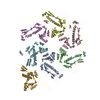
|
|---|---|
| 1 | x 60
|
- Components
Components
| #1: Protein | Mass: 35258.426 Da / Num. of mol.: 7 Source method: isolated from a genetically manipulated source Source: (gene. exp.)  Bacillus phage SPP1 (virus) / Gene: 13 / Production host: Bacillus phage SPP1 (virus) / Gene: 13 / Production host:  |
|---|
-Experimental details
-Experiment
| Experiment | Method: ELECTRON MICROSCOPY |
|---|---|
| EM experiment | Aggregation state: PARTICLE / 3D reconstruction method: single particle reconstruction |
- Sample preparation
Sample preparation
| Component | Name: Bacillus phage SPP1 / Type: VIRUS / Entity ID: all / Source: NATURAL |
|---|---|
| Molecular weight | Experimental value: NO |
| Source (natural) | Organism:  Bacillus phage SPP1 (virus) Bacillus phage SPP1 (virus) |
| Details of virus | Empty: NO / Enveloped: NO / Isolate: OTHER / Type: VIRION |
| Natural host | Organism: Bacillus subtilis |
| Virus shell | Name: procapsid II / Diameter: 600 nm / Triangulation number (T number): 7 |
| Buffer solution | pH: 7 |
| Specimen | Embedding applied: NO / Shadowing applied: NO / Staining applied: NO / Vitrification applied: YES |
| Specimen support | Grid material: COPPER / Grid mesh size: 400 divisions/in. / Grid type: Quantifoil R2/2 |
| Vitrification | Instrument: FEI VITROBOT MARK II / Cryogen name: ETHANE / Humidity: 100 % / Chamber temperature: 293 K |
- Electron microscopy imaging
Electron microscopy imaging
| Experimental equipment |  Model: Tecnai Polara / Image courtesy: FEI Company |
|---|---|
| Microscopy | Model: FEI POLARA 300 |
| Electron gun | Electron source:  FIELD EMISSION GUN / Accelerating voltage: 300 kV / Illumination mode: OTHER FIELD EMISSION GUN / Accelerating voltage: 300 kV / Illumination mode: OTHER |
| Electron lens | Mode: BRIGHT FIELD / Nominal magnification: 39000 X / Calibrated magnification: 39000 X / Nominal defocus max: 3000 nm / Nominal defocus min: 900 nm / Calibrated defocus min: 900 nm / Calibrated defocus max: 3000 nm / Cs: 2.3 mm / C2 aperture diameter: 100 µm / Alignment procedure: BASIC |
| Specimen holder | Cryogen: NITROGEN Specimen holder model: GATAN 910 MULTI-SPECIMEN SINGLE TILT CRYO TRANSFER HOLDER Temperature (max): 85 K / Temperature (min): 70 K |
| Image recording | Average exposure time: 5 sec. / Electron dose: 1.1 e/Å2 / Detector mode: SUPER-RESOLUTION / Film or detector model: GATAN K2 SUMMIT (4k x 4k) / Num. of grids imaged: 1 / Num. of real images: 7000 |
| Image scans | Sampling size: 5 µm / Width: 3840 / Height: 3712 / Movie frames/image: 25 / Used frames/image: 4-21 |
- Processing
Processing
| EM software |
| ||||||||||||||||||||||||||||||||||||||||
|---|---|---|---|---|---|---|---|---|---|---|---|---|---|---|---|---|---|---|---|---|---|---|---|---|---|---|---|---|---|---|---|---|---|---|---|---|---|---|---|---|---|
| CTF correction | Type: PHASE FLIPPING ONLY | ||||||||||||||||||||||||||||||||||||||||
| Particle selection | Num. of particles selected: 11745 | ||||||||||||||||||||||||||||||||||||||||
| Symmetry | Point symmetry: I (icosahedral) | ||||||||||||||||||||||||||||||||||||||||
| 3D reconstruction | Resolution: 4.2 Å / Resolution method: FSC 0.5 CUT-OFF / Num. of particles: 8808 / Algorithm: EXACT BACK PROJECTION / Symmetry type: POINT | ||||||||||||||||||||||||||||||||||||||||
| Atomic model building | Protocol: FLEXIBLE FIT / Space: REAL |
 Movie
Movie Controller
Controller




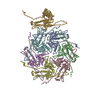

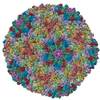
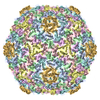
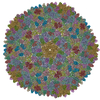
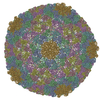
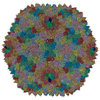
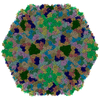
 PDBj
PDBj
